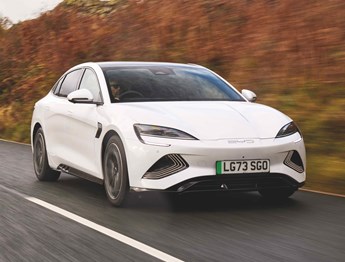We use cookies to ensure that we give you the best experience on our website. If you continue without changing your settings, we will assume that you are happy to receive all cookies on the Business Car website. However, if you would like to, you can change your cookies at any time

The start point for the best source of fleet information |
First drive: BYD Seal
Date: 22 December 2023 | Author: Martyn Collins

|
|
||||||||||||||||
It's clear 2023 has been an impressive debut for BYD, the Chinese EV brand, in the UK. It has gone from nowhere to a three-model range since March. The first was the Atto 3, which made an impact with its tidy and competent drive, standard equipment, and spacious interior. This was quickly followed by the Dolphin supermini, with its excellent performance and roomy cabin.
The Seal is BYD's halo model and UK range-topper, its most obvious rival being the Tesla Model 3. However, the Chinese manufacturer is also going after the BMW i4, Hyundai Ioniq 6 and the Volkswagen ID 7. Outside, in our opinion, the Seal is BYD's best effort yet. There's definitely some European influence on the curvy saloon car shape. The fact that part of the Seal's detailing looks similar to the Porsche Taycan is more than coincidental. Listening to public opinion, the Seal is the brand's first model not to have the cheesy 'Build Your Dreams' lettering across the back of the car, and in our opinion looks much better for it.
After the slightly 'out there' design theme of the Atto 3's interior, the Seal is pleasingly conventional. Quality, although by no means bad on BYD's other models, has stepped up for this car. The supportive seats are trimmed in believable, soft-touch faux leather. The roof pillars and dashboard are finished in classy faux suede and the 10.25in driver display is more conventionally shaped than those seen in the Atto 3 and Dolphin. Elsewhere, the driving position is comfortable and there's plenty of space front and back, plus a decent amount of stowage, too.
It is not quite perfect, though. The same strong plastic-like smell we've previously experienced in both Atto 3 and Dolphin is present in the Seal and it's not nice. The stalks are the same as those fitted to the rest of the BYD range - they felt cheap in those and feel even worse in the Seal. The large 15.6in touchscreen works well but has too many confusing menus. The curvy roof line leaves tall passengers' heads perilously close to the roof, and the boot, with 402 litres, is average and is surprisingly shallow. However, there is a 53-litre 'frunk' at the front for the charging cables.
Under the body and interior is the same e-Platform 3.0 scalable platform as in the Atto 3. However, the 82kWh lithium-ion 'Blade' battery is a structural part of the car, with the top being part of the Seal's floor. There are two Seal versions, the first being a 308hp Design, single-motor, rear-wheel drive version, which boasts 354 miles of range, and acceleration to 62mph in 5.9 seconds. The other is the range-topping 523hp, twin-motor Excellence version, with all-wheel drive. Interestingly, this Seal is more powerful and accelerates more quickly to 62mph than the Tesla Model 3 Long Range, which is where the 3.8S badge on the boot lid comes from. When it's time to charge, all Seals can take AC and DC charging up to 150kW, which is good enough to equal a 10-80% charge in under 30 minutes.
We got the chance to drive both versions on the road and track, and this is where the Blade battery and scalable platform equal perfect weight distribution. You can still feel the weight, but it's well-controlled and with precise steering, whether you choose rear or all-wheel drive, it's a fun and involving experience. Unless you really need the extra power of the 3.8S, the rear-drive version is almost as grippy, capable and rides slightly more confidently.
Specifications are identical for rear drive and all-wheel drive versions, with plenty of standard kit as you'd expect. Demand fleet-wise is expected to be evenly split between the two versions.
The BYD Seal is an impressive EV package. Not only does it look good, with a spacious and well-equipped interior, it is a fun drive, a generally refined ride and all with decent efficiency.
BYD Seal Design 83kWh
P11D: £45,640
Residual value: 43.7%
Depreciation: £25,040
Fuel: £3,824
Service, maintenance and repair: £3,988
Cost per mile: 54.75p
Range: 354 miles
CO2 (BIK %): 0g/km (2%)
BIK 20/40% a month: £15/£30
Luggage capacity: 402 litres
Battery size/power: 83kWh/308hp
Verdict |
8/10 |
|||
 |
|
 |
|
|











